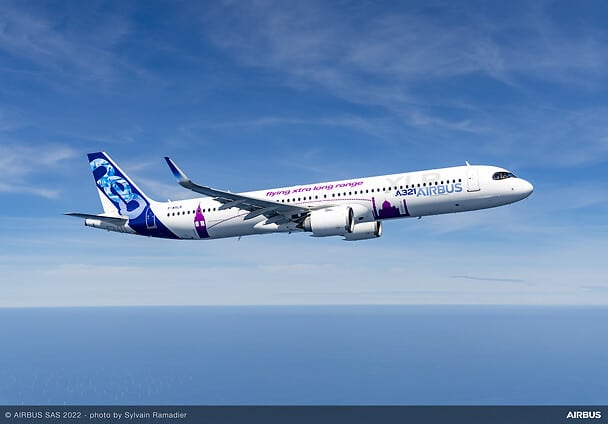Aviation
Airbus A321XLR Secures EASA Approval, Ready for Commercial Debut

In a significant milestone for Airbus, the A321XLR powered by CFM LEAP-1A engines has received its Type Certification from the European Union Aviation Safety Agency (EASA).
The Type Certificate was officially handed over by Florian Guillermet, Executive Director of EASA, to Isabelle Bloy, A321XLR Chief Engineer. This certification paves the way for the entry-into-service of the new aircraft, anticipated at the end of the summer.
The certification of the A321XLR variant equipped with Pratt & Whitney engines is expected later in 2024. Christian Scherer, CEO of the Commercial Aircraft business of Airbus, expressed his excitement about the new aircraft, stating, “Here comes the A321XLR, a differentiated product that brings new value to the market, expanding the possibilities for our airline customers and passengers.
American airlines Insight view of A321XLR:Click here
With its long range, the A321XLR enables a host of new direct routes, offering natural growth opportunities to our customers and the travelling public. It provides airlines with the efficiency of commonality inside the A320/A321 product range and its versatile cabin a range of service possibilities that are just unique. It is quintessential Airbus!”
The certification represents a key milestone in the journey of the A321XLR. The next phase involves preparing the aircraft for its first commercial missions with customers worldwide. Scherer added, “We look forward to working with XLR customers to support the integration of the aircraft in their fleets.”
Airbus is set to increase the production rate for A350:Click here
The A321XLR, with its impressive capabilities, complements widebody aircraft in an airline’s fleet. It offers the flexibility to add capacity, open new routes, or maintain existing ones when demand fluctuates.
This aircraft stands out by burning 30% less fuel per seat compared to previous generation competitor aircraft, and at approximately half the trip cost of modern widebodies. Its new Airspace cabin promises passengers long-haul comfort across all classes.
The first A321XLR completed its maiden flight in June 2022, followed by an extensive test program involving three test aircraft. To date, more than 500 Airbus A321XLRs have been ordered, highlighting the strong demand and confidence in this innovative aircraft.
With its certification now secured, the A321XLR is poised to make a significant impact on the aviation market, offering airlines a versatile, efficient, and cost-effective solution for a variety of routes and operational needs.

Aviation
COMAC Unveils Plans for the C929 to Rival Airbus and Boeing

After the success of China’s first C919 aircraft, the country is setting its sights on developing a larger plane. COMAC (Commercial Aircraft Corporation of China) has officially confirmed plans to build a widebody aircraft, marking a significant step in its aircraft lineup.
Traditionally, Airbus and Boeing dominate the widebody aircraft market, with decades of expertise in developing planes and engines capable of carrying heavy payloads. China, which currently relies on imported engines, is now aiming to challenge these giants with its own widebody jet, the C929, designed to compete with the Airbus A350 and Boeing 777.
American Airlines Is Looking for Flight Attendants: Apply Now
The C929 will be China’s first independently developed long-range widebody aircraft. It adheres to international airworthiness standards and boasts independent intellectual property rights. The baseline version is designed to seat 280 passengers and offers a range of 12,000 kilometers, catering to global demand for both regional and international air travel.
Russia, which also needs reliable narrowbody and widebody aircraft, could become a key customer for the C929. Additionally, China plans to target the broader Asian market as it continues to expand its aviation capabilities.
Close Call at Heathrow: BA Flight Narrowly Escapes Drone Collision
China’s aviation progress includes the ARJ21 (now called C909), a regional jet with 100 seats for shorter routes, and the C919, a narrowbody jet with 180 seats designed to rival the Boeing 737 MAX and Airbus A320. Both models have found increasing demand in the domestic market.
At China’s largest air show in Zhuhai, COMAC announced that Air China will be the launch customer for the C929 widebody jet, though details about order size and delivery timelines were not disclosed.
Other major deals announced by COMAC include:
- Hainan Airlines: Firm orders for 60 C919 and 40 C909 regional jets.
- Colorful Guizhou Airlines: 30 C909 jets, with 20 firm orders and 10 provisional agreements.
The C929, renamed from the CR929 after Russia withdrew from the joint development project in 2023, is expected to carry 280–400 passengers with a range of 12,000 kilometers, competing directly with Boeing’s 787 Dreamliner.
According to COMAC’s deputy general manager, Tong Yu, the first fuselage section of the C929 is expected by September 2027, with prototype test flights anticipated soon after.
-

 Aviation2 months ago
Aviation2 months agoMicrosoft Flight Simulator Raises $3 Million to Bring Back the An-225 Mriya
-

 Airlines2 months ago
Airlines2 months agoQantas Engineers Stage Walkout Over Cost of Living Concerns
-

 Airlines2 months ago
Airlines2 months agoQatar Citizens Can Travel to the United States Without a Visa
-

 Aviation2 months ago
Aviation2 months agoQatar Airways bans these new Electronic Devices on plane
-

 Airlines2 months ago
Airlines2 months agoJapan Airlines Rolls Out Free Domestic Flights to International Passengers
-

 Defence2 months ago
Defence2 months agoWhich Country Has the Largest Fleet of Fighter Aircraft?
-

 Airport2 months ago
Airport2 months agoWestern Sydney Airport Welcomes Its First Plane After 6 Years of construction
-

 Travel2 months ago
Travel2 months agoQatar Airways Launches Four Additional Flights from Amsterdam








